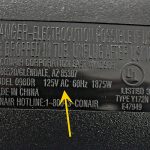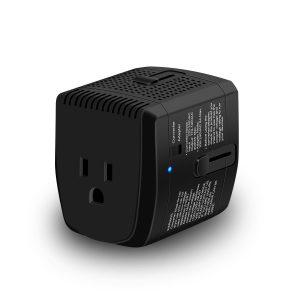While on tour there will come a time when you will need to charge your phone, or maybe you plan on blow drying your hair. Be sure to follow this guide to keep all your devices (and yourself) safe.
Not All Electric is the Same
 In the USA, most consumer products run on 120v 60Hz, but in many other parts of the world this is not the norm. When traveling, you’ll need to know what voltage your destination provides, and you will need to check any electrical devices you plan use on tour to ensure they will properly work with this voltage. You can normally find your device’s information on a label on the plug end or where the cord enters the device. When it doubt google the model number of your device to find the input voltage rating. Thankfully, many of our everyday electronics are manufactured to work with multiple voltages so the only thing that needs to change is the shape of the plug. If you find your device is only rated to work with 120v you will need to purchase a “voltage converter” or leave the device at home. Plugging a device rated for 120v into a 230v outlet will quickly lead to smoke and permanent damage!
In the USA, most consumer products run on 120v 60Hz, but in many other parts of the world this is not the norm. When traveling, you’ll need to know what voltage your destination provides, and you will need to check any electrical devices you plan use on tour to ensure they will properly work with this voltage. You can normally find your device’s information on a label on the plug end or where the cord enters the device. When it doubt google the model number of your device to find the input voltage rating. Thankfully, many of our everyday electronics are manufactured to work with multiple voltages so the only thing that needs to change is the shape of the plug. If you find your device is only rated to work with 120v you will need to purchase a “voltage converter” or leave the device at home. Plugging a device rated for 120v into a 230v outlet will quickly lead to smoke and permanent damage!
Checking Voltages
 Most of our consumer electronics are manufactured to operate across a wide range of voltages, you can find this information under the devices “input voltage”. Most phone chargers are rated from 110-240v which will work pretty much anywhere in the world, but this is not always the case. Check all your devices before leaving home; don’t assume anything. On the other hand, hair dryers, curlers, straighteners, etc. often times will only be rated for 120v, unless they are advertised as being “dual voltage.” Dual voltage products will likely have a switch on them to change between 120v and 220-240v. Camera battery chargers and laptops can be hit or miss so you will need to verify that your device will operate at the provided input voltage. If in doubt bring your device to a meeting, and we will help you figure it out.
Most of our consumer electronics are manufactured to operate across a wide range of voltages, you can find this information under the devices “input voltage”. Most phone chargers are rated from 110-240v which will work pretty much anywhere in the world, but this is not always the case. Check all your devices before leaving home; don’t assume anything. On the other hand, hair dryers, curlers, straighteners, etc. often times will only be rated for 120v, unless they are advertised as being “dual voltage.” Dual voltage products will likely have a switch on them to change between 120v and 220-240v. Camera battery chargers and laptops can be hit or miss so you will need to verify that your device will operate at the provided input voltage. If in doubt bring your device to a meeting, and we will help you figure it out.
Plug Adapters
 Type A and Type B plugs (USA style plug ends) will not fit the outlets you’ll find in most other parts of the world. Even when traveling with properly voltage rated devices, you will need to use a plug adapter. These can be purchased in a kit if you plan to travel to many different locations, or you can check out this site to figure out which style adapter will fit the outlets in the country where you are traveling. Hotels are often short on places to plug things in, so if you’re traveling with a bunch of things that need to be charged (phone, camera batteries, etc.) you may consider bringing a plug strip. But be warned– most of the plug strips found in the USA are only rated for 120v and will instantly fail when plugged into a 230v outlet. If you really need you a plug strip, search for one that’s rated for up to 240v.
Type A and Type B plugs (USA style plug ends) will not fit the outlets you’ll find in most other parts of the world. Even when traveling with properly voltage rated devices, you will need to use a plug adapter. These can be purchased in a kit if you plan to travel to many different locations, or you can check out this site to figure out which style adapter will fit the outlets in the country where you are traveling. Hotels are often short on places to plug things in, so if you’re traveling with a bunch of things that need to be charged (phone, camera batteries, etc.) you may consider bringing a plug strip. But be warned– most of the plug strips found in the USA are only rated for 120v and will instantly fail when plugged into a 230v outlet. If you really need you a plug strip, search for one that’s rated for up to 240v.
Voltage Converters
 If there’s a device that you ABSOLUTELY NEED to bring with you on tour that is only rated for 120v you will have to purchase a voltage converter. Converters will safely change the the provided input voltage to 120v for safe operation. Purchasing the right converter takes a little more research than a simple plug adapter, and you’ll find converters are significantly more expensive than plug adapters. Converters are rated by their output wattage so you will need to figure out how many watts your device consumes, and while some devices many list the wattage on it’s electrical label, more often this will be listed by how make Amps the device consumes. Amps are easily converted into watts by multiplying the amps into the voltage (for example, 2.5 amps X 110v = 275 watts). If you find you need to bring a converter on tour you could bring a normal plug strip with you and plug it into to converter which would limit the need for plug adapters while giving you more places to plug in. If you plan to use this method you will need to be sure that you’ve bought a converter that will provide enough watts to power all your devices.
If there’s a device that you ABSOLUTELY NEED to bring with you on tour that is only rated for 120v you will have to purchase a voltage converter. Converters will safely change the the provided input voltage to 120v for safe operation. Purchasing the right converter takes a little more research than a simple plug adapter, and you’ll find converters are significantly more expensive than plug adapters. Converters are rated by their output wattage so you will need to figure out how many watts your device consumes, and while some devices many list the wattage on it’s electrical label, more often this will be listed by how make Amps the device consumes. Amps are easily converted into watts by multiplying the amps into the voltage (for example, 2.5 amps X 110v = 275 watts). If you find you need to bring a converter on tour you could bring a normal plug strip with you and plug it into to converter which would limit the need for plug adapters while giving you more places to plug in. If you plan to use this method you will need to be sure that you’ve bought a converter that will provide enough watts to power all your devices.

No Comments Yet